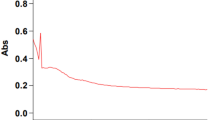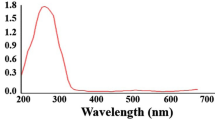Abstract
Today propose diverse techniques to remedy cancer and nanotechnology is one of the most effective cancer treatments. In this study, we detail a simple and environmentally friendly approach for synthesizing copper nanoparticles (CuNPs) using Thymus fedtschenkoi leaves extract. Studies on the structure, morphological, optical, cytotoxic, and anti-lung cancer properties of the CuNPs were conducted. The XRD pattern shows that CuNPs have a highly crystalline nature and exhibit a cubic crystal system. In order to evaluate the shape and size of the produced NPs, FE-SEM and HR-TEM were employed. The findings of the current study indicated that CuNPs had a significant growth-inhibiting effect on the lung cancer cell lines: NCI-H661, NCI-H1975, NCI-H1573, and NCI-H1563. Furthermore, the cytotoxicity effect against Human umbilical vein endothelial cells (HUVEC) was not seen at concentrations as high as 1000 μg/mL for these NPs. CuNPs are expected to be employed as a medication to treat lung cancer in upcoming clinical trials after passing the in vivo tests.
Graphical Abstract
Thymus fedtschenkoi extract was employed to green synthesis of copper nanoparticles (CuNPs). CuNPs were characterized using FT-IR, TEM, XRD, SEM, DLS and UV/Vis. The anticancer, antioxidant and cytotoxicity activities of CuNPs were evaluated. The finding of biological activities showed that these CuNPs could be used as a drug to lung cancer therapy.








Similar content being viewed by others
Data Availability
The data presented in this manuscript is new and has not been published elsewhere. This data includes figures (plots and images), and tables.
References
M. G. Mokwena, et al. (2018). Photodiagn. Photodyn. Ther. 22, 147.
F. Badrzadeh, et al. (2016). Artif. Cells Nanomed. Biotechnol. 44 (2), 618.
K. C. Sadanala, et al. (2014). Anticancer Res. 34 (9), 4657.
J. Adizie, et al. (2019). Clin. Oncol. 31 (10), 688.
M. Zhang, et al. (2021). Acta Biomater. 124, 327.
J.-P. Pignon, et al., in. 2008, Centre for Reviews and Dissemination (UK).
V. Malyla, et al. (2020). Fut. Med. Chem. 12 (7), 567.
A. T. Nkembo, et al. (2019). Curr. Cancer Drug Targets 19 (10), 838.
E. Ercetin, et al. (2019). Cancers 11 (9), 1306.
P. Sharma, et al. (2019). Chem. Biol. Interact. 309, 108720.
C. Rolfo, et al. (2014). Cancer Treat. Rev. 40 (8), 990.
J. Klastersky and A. Awada (2012). Crit. Rev. Oncol. Hematol. 81 (1), 49–57.
M. J. Bott, et al. (2015). Ann. Thorac. Surg. 99 (6), 1921.
P. A. Bunn Jr. (2004). J. Natl. Compr. Cancer Netw. 2, S31.
B. Sun, et al. (2019). Artif. Cells Nanomed. Biotechnol. 47 (1), 4012.
S. Chakraborty and T. Rahman (2012). Ecancermedicalscience 6, ed16.
C. Kleinstreuer, Y. Feng, and E. Childress (2014). World J. Clin. Cases 2 (12), 742.
M. S. Jabir, et al. (2021). Artif. Cells Nanomed. Biotechnol. 49 (1), 48.
R. Mohammadian, M. M. Amini, and A. Shaabani (2020). Catal. Commun. 136, 105905.
R. Mohammadian, et al. (2020). ChemistrySelect 5 (33), 10346.
H. Jan, et al. (2020). RSC Adv. 10 (33), 19219.
H. Jan, et al., Oxid. Med. Cell. Longev. 2021 (2021)
S. Haider, et al. (2016). Appl. Surf. Sci. 387, 1154.
T. Kamal, S. B. Khan, and A. M. Asiri (2016). Cellulose 23 (3), 1911.
S. Faisal, et al. (2022). ACS Omega 7 (5), 4071.
S. Faisal, et al. (2021). Coatings 11 (7), 849.
M. Salavati-Niasari, F. Davar, and N. Mir (2008). Polyhedron 27 (17), 3514.
A. Dehnoee, et al. (2023). Micro Nano Lett. 18 (1), e12153.
Z. Heidari, et al. (2018). 3 Biotech 8, 1.
T. Hussain, et al. (2022). J. Saudi Chem. Soc. 26 (4), 101486.
P. Kubatka, et al. (2019). Int. J. Mol. Sci. 20 (7), 1749.
L. Xie, Y. Li, and W. Cheng (2022). J. Drug Deliv. Sci. Technol. 72, 103342.
G. Rajagopal, et al. (2021). Heliyon 7 (6), e07360.
A. P. Ingle, N. Duran, and M. Rai (2014). Appl. Microbiol. Biotechnol. 98, 1001.
Q. Luo, et al. (2021). Redox Biol. 41, 101912.
A. Delazar, et al. (2011). J. Essent. Oil Bear. Plants 14 (1), 23.
H. Ghelichnia (2018).
K. H. C. Başer, et al. (2002). Flavour Fragr. J. 17 (1), 41.
A. Mohammadi-Liri, et al. (2022). Chem. Pap., 1.
S. Bhavana, et al. (2022). Inorg. Nano-Met. Chem., 1
P. Yugandhar, et al. (2017). Appl. Nanosci. 7, 417.
J. Bai, et al. (2021). J. Exp. Nanosci. 16 (1), 397.
K. D. Arunachalam, S. K. Annamalai, and S. Hari (2013). Int. J. Nanomed. 8, 1307.
D. Ma, et al. (2020). Int. J. Biol. Macromol. 165, 767.
J. Wang, et al. (2021). Mater. Chem. Phys. 257, 123375.
Z. Shi, et al. (2021). Arab. J. Chem. 14 (8), 103224.
C. He, et al. (2021). J. Environ. Chem. Eng. 9 (6), 106393.
G. Zhao, et al. (2021). Arch. Med. Sci.
Y. Lu, et al. (2021). J. Market. Res. 12, 1832.
A. Ahmeda, A. Zangeneh, and M. M. Zangeneh (2020). Appl. Organomet. Chem. 34 (2), e5378.
S. Hemmati, et al. (2020). Appl. Organomet. Chem. 34 (2), e5267.
M. Raja, et al. (2008). Mater. Manuf. Process. 23 (8), 782.
T. Wang, et al. (2014). Sci. Total Environ. 466, 210.
R. Hassanien, D. Z. Husein, and M. F. Al-Hakkani (2018). Heliyon 4 (12), e01077.
O. C. Olatunde and D. C. Onwudiwe (2021). Front. Mater. 8, 687562.
S. A. Aldahash, S. Siddiqui, and M. K. Uddin (2023). J. Nat. Fibers 20 (2), 2224976.
I. M. Chung, et al. (2017). Exp. Ther. Med. 14 (1), 18.
A. Munin and F. Edwards-Lévy (2011). Pharmaceutics 3 (4), 793.
H. Murthy, et al. (2020). J. Nanomater. 2020, 1–12.
Z. N. Kayani, et al. (2015). J. Electron. Mater. 44 (10), 3704.
M. Rezzoug, et al. (2019). BMC Complement. Altern. Med. 19 (1), 1.
R. Subbaiya, et al. (2014). Int. J. Curr. Microbiol. Appl. Sci 3 (1), 83.
H. J. Lee, J. Y. Song, and B. S. Kim (2013). J. Chem. Technol. Biotechnol. 88 (11), 1971.
S. Sumathi, et al. (2013). Int. J. Pharmacol. Sci. Invent 2, 21–26.
M. Roberson, et al. (2014). Nano Life 4 (01), 1440003.
U. Jinu, et al. (2017). Microb. Pathog. 105, 86.
J. Sahu, P. K. Patel, and B. Dubey (2012). Int. J. Pharm. Phytopharmacol. Res 1 (5), 313.
R. Mukhopadhyay, J. Kazi, and M. C. Debnath (2018). Biomed. Pharmacother. 97, 1373.
H. Liu, et al. (2021). J. Exp. Nanosci. 16 (1), 410.
J. Gu, et al. (2023). Inorg. Chem. Commun. 150, 110442.
J. Gu, A. Aidy, and S. Goorani (2022). J. Exp. Nanosci. 17 (1), 285.
J. Chen. (2022). Authorea Preprints.
R. Sankar, et al. (2014). Mater. Sci. Eng. C 44, 234.
S. Harne, et al. (2012). Colloids Surf. B 95, 284.
D. Rehana, et al. (2017). Biomed. Pharmacother. 89, 1067.
H. Raveesha and L. Pramila (2022). Indian J. Sci. Technol. 15 (22), 1075.
Funding
Not applicable
Author information
Authors and Affiliations
Contributions
AD: conceptualization, methodology, software, data curation, writing original draft preparation, visualization, investigation, interpretation of analysis data. RJK: supervision, writing-reviewing and editing. MMZ and AZ: biological evaluation. MRD: supervision.
Corresponding authors
Ethics declarations
Competing Interests
Authors declare no competing interests.
Ethical Approval
In this study, no human or animal studies were conducted.
Additional information
Publisher's Note
Springer Nature remains neutral with regard to jurisdictional claims in published maps and institutional affiliations.
Supplementary Information
Below is the link to the electronic supplementary material.
Rights and permissions
Springer Nature or its licensor (e.g. a society or other partner) holds exclusive rights to this article under a publishing agreement with the author(s) or other rightsholder(s); author self-archiving of the accepted manuscript version of this article is solely governed by the terms of such publishing agreement and applicable law.
About this article
Cite this article
Dehnoee, A., Javad Kalbasi, R., Zangeneh, M.M. et al. Characterization, Anti-lung Cancer Activity, and Cytotoxicity of Bio-synthesized Copper Nanoparticles by Thymus fedtschenkoi Leaf Extract. J Clust Sci 35, 863–874 (2024). https://doi.org/10.1007/s10876-023-02512-w
Received:
Accepted:
Published:
Issue Date:
DOI: https://doi.org/10.1007/s10876-023-02512-w




